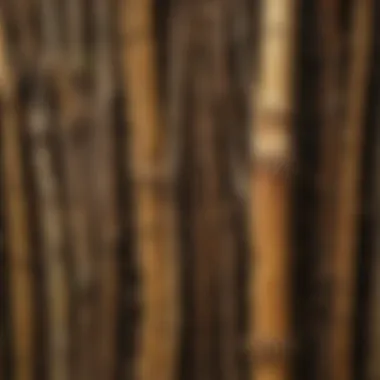Unveiling the Enigmatic Charms of Petrified Bamboo: A Geological Marvel


Rock and Fossil Identification
To commence our journey into the realm of petrified bamboo, it is crucial to first understand the significance of rock and fossil identification. Petrified bamboo, a rare geological marvel, showcases distinct characteristics that set it apart from conventional rocks and fossils. By examining the texture, color, and formation patterns, collectors can differentiate petrified bamboo from other petrified vegetation with precision. Utilizing specialized tools such as magnifying lenses and hardness picks enables enthusiasts to delve deeper into the intricate details and variations present in these petrified specimens.
Collecting Tips and Techniques
For avid collectors eager to add petrified bamboo to their geological treasures, mastering essential collecting tips and techniques is paramount. Prime collecting sites, typically rich in silicified wood deposits, offer ideal hunting grounds for these prized relics. Employing cautious excavation practices ensures the safe extraction of petrified bamboo specimens without compromising their integrity. By embracing best practices like conducting thorough research on geological formations and obtaining necessary permits, collectors can navigate the terrain effectively and ethically.
Preservation and Display
Preserving petrified bamboo requires a delicate balance of scientific expertise and creative finesse. Employing proven techniques such as consolidation treatments and protective coatings helps safeguard these delicate specimens from environmental degradation. Implementing proper storage methods, such as climate-controlled cabinets or archival containers, ensures longevity and sustained aesthetic appeal. When it comes to creative display ideas, incorporating natural elements like polished wood stands or custom-designed mounts elevates the visual impact of petrified bamboo exhibits, captivating audiences with their timeless beauty.
Geological Insights
Petrified bamboo not only serves as a geological curiosity but also offers valuable insights into ancient ecosystems and environmental dynamics. The process of petrification, wherein organic material transforms into stone through mineral replacement, sheds light on the intricate interplay between biological processes and geological forces. Exploring the historical significance of petrified bamboo unveils its role as a time capsule, preserving tales of bygone eras and contributing to our understanding of natural history. Notable discoveries in the field continue to expand our knowledge of prehistoric plant life and evolution, reinforcing the importance of petrified bamboo as a key player in Earth's geological narrative.
Introduction
As you embark on a journey through the intricate world of petrified bamboo, it is crucial to understand the significance of this topic within the geological spectrum. Petrified bamboo holds within its stone-like structure a wealth of information about ancient ecosystems and the geological processes that have shaped our planet over millennia. By exploring the mysteries of petrified bamboo, we are able to unearth clues that provide invaluable insights into the history of our Earth.
Exploring the Enigmatic Petrified Bamboo
The Fascinating Origins of Petrified Bamboo
The origins of petrified bamboo date back to ancient times when these once living organisms underwent a remarkable transformation into stone. This process, which entails the gradual replacement of organic materials with minerals, results in the stunning preservation of delicate bamboo structures. The unique parallel between the former flexibility of bamboo and its current stonelike form presents researchers with a visually captivating testament to the passage of time and the power of geological forces.
The Significance of Petrified Bamboo in Geological Collections
Petrified bamboo holds a special place in geological collections due to its dual nature of being both a fossil and a stone. Its presence in collections worldwide allows scientists and enthusiasts alike to study not only the biology of ancient bamboo species but also the petrification process itself. This tangible link to the past serves as a crucial educational tool, offering a visual representation of the earth's transformative cycles and the mysteries that lie within.
Understanding the Petrification Process


The Transformation of Bamboo into Stone
The remarkable transformation of bamboo into stone is a testament to the enduring nature of geological processes. Through a series of complex chemical interactions, the cellular structure of bamboo is gradually replaced by minerals, resulting in a petrified specimen that retains the essence of its original form. This transformation offers a window into the past, allowing us to witness firsthand the slow but steady march of time captured within the stone.
Factors Influencing the Petrification of Bamboo
Numerous factors influence the petrification of bamboo, including environmental conditions, mineral composition, and the presence of sedimentation. Variables such as the acidity of the surrounding soil, the availability of minerals, and the duration of the petrification process all play a role in determining the final qualities of a petrified bamboo specimen. By studying these factors in detail, scientists gain a deeper understanding of the intricate processes that govern the transformation of organic matter into stone.
Formation of Petrified Bamboo
As we delve into the captivating realm of petrified bamboo, the formation process emerges as a vital facet of understanding this geological wonder. Petrification, a unique transformation from organic matter to stone, captivates the imagination of geological enthusiasts, rock and fossil collectors, and scholars alike. In this article, the formation of petrified bamboo acts as a foundational pillar, shedding light on the intricate processes that lead to the preservation of bamboo specimens for millennia. Readers will uncover the specific environmental conditions, time frames, and geological factors that contribute to the mesmerizing petrification of bamboo.
Environmental Conditions for Petrification
Role of Minerals in the Petrification Process
Exploring the role of minerals in the petrification of bamboo reveals a fascinating interplay between organic matter and inorganic compounds. The infusion of minerals seeps into the cellular structures of bamboo, gradually replacing organic components with inorganic substances. This meticulous process ensures the meticulous preservation of intricate details and textures, converting bamboo into a stone-like state while retaining its original form. Minerals serve as the building blocks of petrified bamboo, fortifying its structural integrity and enhancing its visual appeal.
Impact of Sedimentation on Bamboo Fossilization
Sedimentation plays a crucial role in the fossilization of bamboo, acting as a protective blanket that shields the delicate structures of the plant. Over time, sediment layers gradually encase bamboo specimens, sealing them off from external elements that could lead to decay. This natural entombment process fosters the slow but steady transformation of bamboo into stone, ensuring the long-term preservation of its features. Sedimentation acts as a time capsule, capturing ancient ecosystems within petrified bamboo and providing researchers with valuable insights into prehistoric landscapes.
Time Frame for Bamboo Petrification
The Slow Petrification of Bamboo Specimens
The gradual petrification process of bamboo specimens unfolds over centuries, epitomizing the patience and intricacy of geological transformations. Each layer of mineral infusion takes time to solidify, gradually turning bamboo into a durable stone replica of its former self. This gradual metamorphosis preserves not just the outer appearance but also the internal structures of bamboo, offering a glimpse into its anatomical intricacies. The slow petrification of bamboo specimens highlights the meticulous nature of geological processes and the enduring allure of petrified relics.
Geological Factors Influencing Petrification Duration
Various geological factors influence the duration of petrification, determining the speed and quality of the transformation from organic to mineralized state. Factors such as temperature, pressure, and mineral composition play integral roles in shaping the petrification process. While some environments promote rapid fossilization, others encourage a slower, more precise transformation that results in exquisitely preserved petrified bamboo specimens. Understanding these geological influences enhances our appreciation for the intricate dance between nature and time captured in petrified bamboo.


Characteristics of Petrified Bamboo
In this enlightening section of the article, the focus shifts towards the intricate details that make up the essence of Petrified Bamboo. The characteristics of Petrified Bamboo play a vital role in uncovering the mysteries surrounding this geological wonder. By scrutinizing the texture, coloration, and structural integrity of Petrified Bamboo, enthusiasts can unravel a treasure trove of information vital to understanding its formation and significance.
Texture and Coloration of Petrified Bamboo
Examining the Smooth Surface of Petrified Bamboo
The examination of the smooth surface of Petrified Bamboo opens a window into its historical journey of petrification and preservation processes . The seamless texture found on Petrified Bamboo specimens not only mesmerizes collectors and researchers but also serves as a crucial element in identifying the authenticity and quality of these fossils. The smoothness of the surface is a testament to the meticulous petrification process that has encapsulated the organic characteristics of bamboo into a timeless stone form, retaining every delicate detail with precision . This feature not only adds aesthetic value to Petrified Bamboo but also aids in distinguishing between various specimens based on their texture and smoothness, making it a valuable asset in geological collections .
Variations in Color Patterns Among Petrified Bamboo Samples
Exploring the palette of color patterns among Petrified Bamboo samples reveals a kaleidoscope of hues that narrate a story of environmental influences and mineral intrusions during the petrification process. The diverse range of colors, from earthy browns to vibrant reds, offers a visual feast for collectors and researchers alike . These color variations provide insights into the composition of minerals and sediments present during the petrification of bamboo, highlighting the dynamic nature of this transformation. Understanding these color patterns not only adds a layer of aesthetic intrigue to Petrified Bamboo but also aids in determining geographical origins and environmental conditions during its fossilization .
Structural Integrity of Petrified Bamboo
Embarking on a journey to uncover the structural integrity of Petrified Bamboo sheds light on the durability and robustness of these ancient treasures . The preservation of Bamboo's internal structure showcases the resilience of this material, portraying an intricate network of fibers and vascular bundles frozen in time . This preservation not only serves as a window into ancient botany but also offers valuable data for scientific studies and research in the field. The strength and durability of Petrified Bamboo stand as a testament to its longevity and resistance to decay . It is this remarkable feature that continues to captivate enthusiasts and researchers, making it a prized possession in geological and educational spheres .
Significance of Petrified Bamboo
Petrified bamboo holds a significant position in the domain of geological treasures, offering a window into ancient ecosystems and the geological history of our planet. This section delves into the profound importance that petrified bamboo bears within the context of this informative article. Discussed herein are the specific characteristics, benefits, and considerations that highlight the intrinsic value of petrified bamboo.
Scientific and Aesthetic Value
In dissecting the scientific and aesthetic value of petrified bamboo, we unravel the dual significance it brings to the table. Aesthetic allure meets scientific curiosity in the examination of ancient ecosystems through bamboo fossils. This unique exploration provides unparalleled insights into the dynamics of past environments, offering scientists and enthusiasts a glimpse into the paleontological tapestry of yesteryears.
Insights into Ancient Ecosystems through Bamboo Fossils
The avenue of examining ancient ecosystems through bamboo fossils serves as a crucial portal for piecing together the puzzle of prehistoric environments. From deciphering the floral composition to understanding the cohabitation of ancient flora and fauna, bamboo fossils grant researchers a blueprint of bygone ecologies. The allure of this exploration lies in the intricate details preserved within petrified bamboo, showcasing the rich narrative of Earth's history through fossilized remains. Advantages of this method include a meticulous peek into past ecosystems, allowing for comprehensive studies of climatic conditions and biodiversity shifts throughout geological ages.
The Allure of Petrified Bamboo in Decorative Arts


Transitioning to the realm of decorative arts, petrified bamboo accentuates the aesthetic domain with its unique allure. The combination of natural textures and patterns in petrified bamboo renders it a popular choice among artists and collectors alike. This section highlights the transformative essence of petrified bamboo in decorative applications, from intricate carvings to ornate furnishings. The advantages of utilizing petrified bamboo in decorative arts lie in its timeless appeal and visual sophistication, bridging the realms of nature and artistry effortlessly.
Educational and Research Applications
Peering into the educational and research applications of petrified bamboo unveils a world of possibilities in geological studies and student engagement. The utilization of petrified bamboo as a didactic tool enriches learning experiences, fostering a deeper understanding of the petrification process and the significance of fossils in geological contexts.
Utilizing Petrified Bamboo in Geological Studies
Petrified bamboo stands as a cornerstone in geological studies, offering a tangible connection to past environments and evolution. By scrutinizing the mineral composition and sedimentary layers encapsulating bamboo fossils, researchers can map out geological timelines and environmental shifts with precision. The advantages of utilizing petrified bamboo in geological studies encompass its durability and authenticity as relics of past landscapes, providing invaluable data for reconstructing geological narratives.
Engaging Students with the Mysteries of Petrification
For educators and mentors, engaging students with the mysteries of petrification portrays a stimulating journey into Earth's antiquity. By incorporating petrified bamboo specimens into educational curricula, students are beckoned into a realm of scientific inquiry and historical exploration. The unique feature of this engagement lies in its interactive nature, fostering critical thinking skills and a passion for natural sciences. Despite certain challenges in deciphering complex geological concepts, the advantages far outweigh the hurdles, offering a gateway to the past through the enigmatic lens of petrified bamboo.
Preservation and Care of Petrified Bamboo
Preservation and Care of Petrified Bamboo play a pivotal role in maintaining the integrity and longevity of these fascinating geological specimens. The meticulous attention given to preserving petrified bamboo ensures that its beauty and scientific significance endure for generations to come. By exploring specific elements such as cleaning, handling techniques, protection from environmental factors, and appropriate storage, enthusiasts and researchers can safeguard these remarkable pieces of natural history.
Maintaining the Luster of Petrified Bamboo
Cleaning and Handling Techniques for Bamboo Fossils
Cleaning and Handling Techniques are essential aspects of maintaining the luster of petrified bamboo. By employing delicate cleaning methods and precise handling procedures, collectors can prevent damage to the surface texture and coloration of these ancient treasures. Understanding the unique characteristics of each bamboo fossil is crucial in selecting the appropriate cleaning techniques to unveil their true beauty.
Protecting Petrified Bamboo from Environmental Factors
Protecting petrified bamboo from environmental factors is fundamental in ensuring its long-term preservation. Shielding these delicate specimens from factors such as sunlight, moisture, and temperature fluctuations is key to preventing deterioration. Implementing protective measures, such as display cases or climate-controlled storage, can significantly prolong the life and appearance of petrified bamboo pieces.
Display and Storage Considerations
Showcasing Petrified Bamboo in Home or Museum Settings
Displaying petrified bamboo in home or museum settings adds a touch of natural wonder to any environment. Whether used as an educational tool or a decorative piece, showcasing these fossils allows observers to appreciate the intricate details and unique properties of petrified bamboo. Selecting the right display location and lighting conditions can enhance the visual appeal and scientific value of these stunning geological specimens.
Choosing Appropriate Storage Solutions for Bamboo Specimens
When considering storage solutions for bamboo specimens, factors such as humidity levels, light exposure, and spatial constraints must be carefully assessed. Optimal storage conditions, such as archival boxes or climate-regulated cabinets, help maintain the structural integrity and color vibrancy of petrified bamboo over time. By choosing appropriate storage solutions, collectors and researchers ensure the longevity and quality of their precious petrified bamboo collections.







